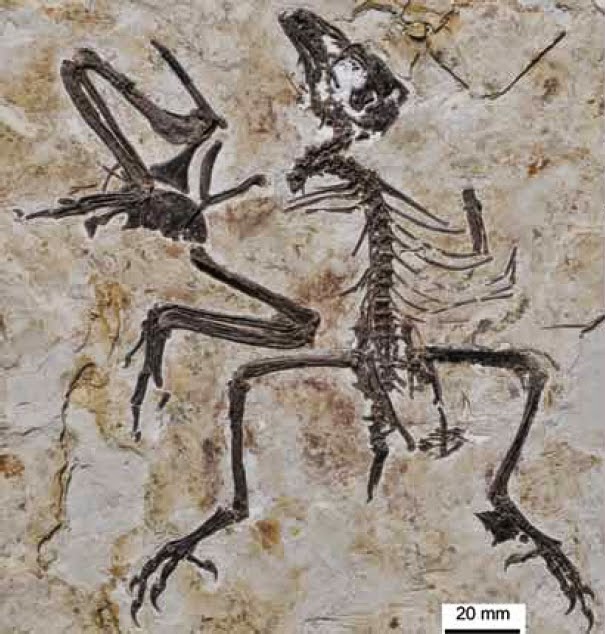Birds evolved from Theropod Dinosaur ancestors in the Jurassic, and
have a fairly extensive Mesozoic fossil record, with around 120 species
described from around the world. The fossil record of Bird’s eggs is much more
limited (unlike that of larger Dinosaurs), though fossil Bird eggs are known
from the Mesozoic of Mongolia, China, Argentina and possibly Spain. The fossil
record of Mesozoic Birds in Brazil, is very limited, comprising a few
fragmentary specimens and feathers, not all of which are universally accepted
as being of avian origin; no Bird eggs have been recorded from the Mesozoic of
Brazil to date.
In a paper published in the journal Alcheringa on 11 June 2014, Júlio Marsola
of the Laboratório de Paleontologia de Ribeirão Preto at the Universidade de SãoPaulo, Gerald Grellet-Tinner of the Centro Regional de Investigaciones La Rioja
at the Consejo Nacional de Investigaciones Científicas y Técnicas, FelipeMontefeltro of the Departamento de Zoologia at the Universidade Estadual Paulista,
Juliana Sayão of the Laboratório de Diversidade do Nordeste, Núcleo de Biologia
at the Universidade Federal de Pernambuco and Annie Schmaltz Hsiou and Max Langer,
also of the Laboratório de Paleontologia de Ribeirão Preto at the Universidade
de São Paulo, report the discovery of a Bird’s egg from the Late Cretaceous Vale
do Rio do Peixe Formation in São Paulo State, Brazil.
The egg is almost complete, but slightly compressed, which probably
occurred during burial, and which is probably responsible for it not being an
obvious egg shape. It is 31.4 mm long and 19.5 mm wide at its widest point.
A nearly complete eggfrom the Late Cretaceous Vale do
Rio do Peixe Formation in São Paulo State, Brazil. Marsola et al. (2014).
The shell of the egg is 125 μm thick, with a very smooth surface and
rounded pore openings. This shell is calcite, and appears to be a good
representation of the original structure, though some re-crystallization has
probably occurred. It is made up of three shell layers, L1, L2 and L3, with L1
averaging 38 μm thick, L2 42 μm thick and L3 45.5 μm thick. Layers L1 and L2
appear to have been laid down horizontally, while L3 (the outermost layer,
which would have been laid down last) has crystals arranged in columns.
SEM of the shell in radial section. Black arrow points
tothe rounded pore opening. Marsola et al. (2014).
The shell is very thin compared to that of modern Neognath Birds
such as Ducks or Chickens, which have shells of about 500 μm in thickness, or
Palaoegnath Birds such as Rheas, which can have shells as thick as 10 mm (small
modern Passerine Birds have thinner shells, but Mesozoic Birds as small as
small Passerines are unknown, and the eggs of small Passerines are themselves
much smaller). Modern Palaeognath Birds typically have a two-layered shell,
third and fourth layers may be present, but when they are are much thinner than
the first two layers. Modern NeognathBirds typically produce a three-layered
shell, but in these eggs the middle layer (L2) is much thicker than the other
two layers. A previously described Bird’s egg from Brazil had a three-layered
egg in which L1 was 92.9 μm thick, L2 58.7 μm thick and L3 14.4 μm thick, and
Bird eggs have also been reported from Argentina in which L1 and L2 were much
thicker than L3. While Theropod eggs of possible avian affinity from Spain had
only two layers. This suggests that the Brazilian egg may come from a Bird
group with no prior fossil eggs recorded, though there is no way of confirming
this.
SEM of the shell in radial section. Arrow indicates a
spherulite core. Note also the delimitation of the shell units and the gradual
(prismatic) contact between L1 and L2, and the abrupt (aprismatic) contact
between L2 and L3. White dashed lines separate the three structural layers, and
a blackdashed line indicates the boundary of shell units. Marsola et al. (2014).
See also…
The deposits of the Jehol Group in northeastern China have yielded a
spectacular number of fossil Birds and closely related non-Avian
Theropod Dinosaurs over the past three decades. The most numerous and
diverse group of Birds in this assemblage are the Enantiornithines,
toothed Birds related but not ancestral to the modern Neornithine Birds,
with about 27...
 A subadult Enantiornithine Bird from the Early Cretaceous Jiufotang Formation of western Liaoning Province.
A subadult Enantiornithine Bird from the Early Cretaceous Jiufotang Formation of western Liaoning Province.
The dominant group of Birds during much of the Cretaceous Period were
the Enatiornithine, toothed Birds related, but not ancestral, to modern
Birds. The largest known species of Enatiornithine from the Early
Cretaceous is Pengornis houi, described from a...
The two surviving groups of Archosaurs, Crocodilians and Birds, show
very different reproductive strategies. Crocodilians have paired
ovaries and produce large clutches of small eggs, which mature slowly
prior to being laid, and make a relatively small investment in parental
care. Birds have only a single ovary, a...
Follow Sciency Thoughts on Facebook.





